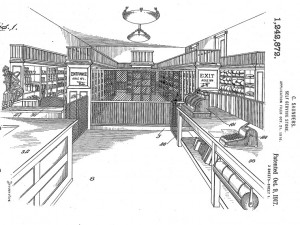Perhaps when you go to the supermarket, you run from aisle to aisle with preplanned precision, picking up only those items you need and finish shopping in the 10 minutes you have allocated.
Perhaps you are a more typical shopper. You let your eyes roam from brightly colored box to brightly colored box. Childlike, you not only test the 43,844 items with your eyes, but you pick them up, shake them, compare weights and set them back down. People less honest than you or me may taste a grape or even slip something into a pocket. You pull out your video phone, point it at the soft drink display, call home, and demand to know “EXACTLY what kind of grape soda do you want?” Finally, you push your shopping cart full of needed and unneeded items to the front of the store, pay and carry everything home.
Grocery shopping 100 years ago was very different. L. Frank Baum's Princess was the only person with a video phone. Stores carried no more than a few hundred boring items. Merchandise was safely behind the counter. In those sexist times, the lady of the house, or perhaps a maid, would give the clerk a list. While the clerk was scooping navy beans out of a barrel and grabbing packages of crackers, the lady chatted with her neighbors. The clerk totaled up the goods and charged them to the family’s account. Months later, after a series of escalating demands and threats to cut off credit, the man of the house stopped by to put a few dollars towards the account.
Perhaps the groceries were delivered, but you would certainly stop off at the butcher shop and the bakery on the way home. The milkman and vegetable seller likely came directly to your house. The delivery cost about three percent and the credit two percent of the bill.
Today you can still get groceries delivered and small food stores are an important part of Chicago. However shopping changed forever when Memphis grocer Clarence Saunders patented the “self-serving store” in 1917. Customers moved through the aisles and the clerk remained at the cash register. Turnstiles and fencing ensured the customer couldn't escape without paying. Also gone were the troublesome credit accounts.
Saunders immediately franchised Piggly Wiggly stores nationwide. Chicago’s first five stores opened in June of 1918. Tribune ads show that Chicago had 60 Piggly Wigglys by 1921. The stores were still small, but you could touch the merchandise.
The times were right for the change. Mass production and processing of food products allowed small individual packages and brand name identification. Chain stores were starting to take over from the thousands of independent groceries. The U.S. was moving from a rural economy, where nobody got paid until the harvest came in, to an industrial economy where workers got cash every day or every week. Chicago by 1926 had over 300,000 automobiles or about one car for every two families. The "cash and carry" concept now worked.
Self-serve competitors soon sprang up. Notable in Chicago were the self-serve Loblaw Groceterias. The Toronto company entered the Chicago market in 1928. In 1932, Chicago’s Jewel Tea Company acquired Loblaw’s 72 Chicago stores and became Jewel Food Stores. A&P, the country’s largest grocery chain, finally adopted self serve in 1936. The era of "don't touch the merchandise" was nearly over.
More information may be found in our histories of the grocery trade such as The Great A&P and the Struggle for Small Business in America, The Rise and Decline of the Great Atlantic & Pacific Tea Company





Add a comment to: Piggly Wiggly: Technology That Changed Chicago